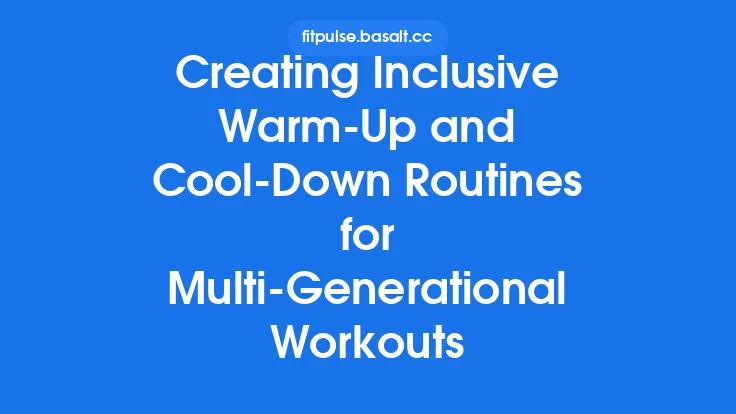After a vigorous home workout, the muscles you’ve just challenged can remain in a state of heightened activation. Even though the physical effort is over, microscopic tension may linger, contributing to stiffness, reduced range of motion, and a lingering sense of fatigue. Progressive Muscle Relaxation (PMR) offers a systematic, evidence‑based method to deliberately release that residual tension, promote circulation, and signal the nervous system that it’s safe to transition into recovery mode. By intentionally tensing and then relaxing specific muscle groups, you create a clear contrast that helps the brain recognize the difference between “tight” and “loose,” accelerating the return to a calm, restorative state.
What Is Progressive Muscle Relaxation?
PMR is a psychophysiological technique first described by Dr. Edmund Jacobson in the early 20th century. The core premise is simple: you voluntarily contract a muscle (or group of muscles) for a few seconds, then release the contraction while focusing on the ensuing sensation of relaxation. Repeating this sequence across the major muscle groups trains the body to detect and let go of unnecessary tension. Over time, practitioners report lower baseline muscle tone, reduced perceived stress, and improved sleep quality—benefits that align perfectly with post‑exercise recovery goals.
Why PMR Works for Post‑Workout Recovery
- Neuromuscular Reset – Intense resistance or cardio sessions stimulate motor units and increase sympathetic nervous system activity. The deliberate “stop‑and‑release” pattern of PMR interrupts this heightened state, allowing the parasympathetic system to regain dominance.
- Enhanced Blood Flow – The brief contraction phase pumps blood into the targeted muscle, while the subsequent relaxation phase encourages venous return. This rhythmic circulation helps clear metabolic by‑products such as lactate and reduces delayed‑onset muscle soreness (DOMS).
- Improved Proprioceptive Awareness – By focusing attention on the feeling of tension and release, you sharpen body awareness. This heightened proprioception can translate into better movement patterns in future workouts, decreasing the risk of overuse injuries.
- Stress Hormone Modulation – Studies show that regular PMR practice can lower cortisol levels. Since cortisol spikes after high‑intensity training, a post‑session PMR routine can help bring hormonal balance back to baseline more quickly.
Structuring a Post‑Workout PMR Routine
A well‑designed PMR session for post‑exercise recovery typically lasts 10–15 minutes and follows a top‑to‑bottom (or bottom‑to‑top) progression. Below is a step‑by‑step template that can be adapted to any fitness level or workout style.
1. Preparation Phase (1–2 minutes)
- Find a Quiet Spot – Choose a space where you won’t be interrupted. A yoga mat or a firm carpet works well.
- Adopt a Comfortable Position – Sit upright with your spine tall, or lie on your back with arms relaxed at your sides. Ensure the posture supports a neutral spine.
- Set an Intention – Briefly remind yourself that the purpose of this session is to release residual tension and promote recovery.
2. Upper‑Body Sequence (4–5 minutes)
| Muscle Group | Tension (3–5 seconds) | Release (8–12 seconds) | Sensation Cue |
|---|---|---|---|
| Hands (fist) | Squeeze tightly, feel the knuckles hardening | Open fingers slowly, notice warmth spreading | “Feel the looseness flow from fingertips to forearm.” |
| Forearms (wrist flexors) | Curl wrists upward, tension in the inner forearm | Release, let the hand drop gently | “Notice the softening of the inner forearm.” |
| Biceps | Bend elbows, contract biceps, hold | Straighten arms, let the muscles melt | “Sense the lengthening of the upper arm.” |
| Shoulders | Shrug shoulders toward ears, hold | Drop shoulders, feel the weight sinking | “Feel the heaviness leaving the shoulder blades.” |
| Neck (sternocleidomastoid) | Tilt head slightly forward, press chin to chest | Return to neutral, let the neck relax | “Notice the space opening at the back of the neck.” |
3. Core and Lower‑Body Sequence (5–6 minutes)
| Muscle Group | Tension (3–5 seconds) | Release (8–12 seconds) | Sensation Cue |
|---|---|---|---|
| Abdominals | Draw belly button toward spine, tighten abs | Unfold, let the belly expand naturally | “Feel the belly rise and fall with ease.” |
| Lower Back (erector spinae) | Arch slightly, engage lumbar muscles | Flatten back onto the floor, let the spine soften | “Sense the gentle release along the spine.” |
| Glutes | Squeeze buttocks together, hold | Release, let hips open | “Notice the widening of the pelvic area.” |
| Hamstrings | Press heels into the floor, contract back of thighs | Release, let legs become heavy | “Feel the lengthening of the back of the legs.” |
| Quadriceps | Tighten front thigh by pressing knees down | Release, let the front of the thigh soften | “Notice the lightness spreading across the front of the thigh.” |
| Calves | Point toes upward, contract calf muscles | Release, let feet relax into a neutral position | “Feel the wave of relaxation travel up from the soles.” |
4. Closing Phase (1–2 minutes)
- Full‑Body Scan – After completing the individual groups, take a moment to mentally scan from head to toe, noting any remaining pockets of tension. If you detect any, repeat a brief contraction‑release cycle for that area.
- Deepening Relaxation – Allow the entire body to rest in its most relaxed state for 30–60 seconds. Breathe naturally, and visualize the muscles bathed in a soothing, warm light.
- Transition Back – Gently wiggle fingers and toes, roll onto one side, and sit up slowly. This gradual transition helps prevent dizziness and reinforces the sense of calm.
Customizing PMR for Different Types of Workouts
| Workout Type | Primary Muscle Fatigue | Tailored PMR Emphasis |
|---|---|---|
| Strength Training (Upper Body) | Deltoids, triceps, forearms | Add extra cycles for shoulders and forearms; incorporate a brief “hand‑grip” segment to counteract grip‑strength fatigue. |
| Leg‑Dominant Strength (Squats, Deadlifts) | Glutes, hamstrings, lower back | Extend the lower‑body sequence, adding a focused “hip‑flexor” contraction (bring knee toward chest) before release. |
| High‑Intensity Interval Training (HIIT) | Full‑body, especially core and calves | Use a faster rhythm (2 seconds tension, 6 seconds release) to match the high‑energy nature, then finish with a slower, deeper relaxation phase. |
| Endurance Cardio (Running, Cycling) | Quadriceps, calves, lower back | Prioritize quadriceps and calves, and include a “pelvic floor” contraction (gentle lift) to aid circulation in the lower torso. |
| Bodyweight Circuits (Burpees, Mountain Climbers) | Shoulders, core, hip flexors | Add a specific hip‑flexor contraction (lift knee toward chest) and a “scapular retraction” step for shoulder stability. |
Frequency and Progression
- Initial Phase (Weeks 1‑2): Perform PMR after every workout session, using the basic 10‑minute template. Focus on mastering the timing of tension and release.
- Intermediate Phase (Weeks 3‑6): Increase the hold time for each contraction to 5 seconds and the release to 12‑15 seconds. Introduce a “double‑cycle” for particularly tight areas (e.g., two consecutive contractions before a longer release).
- Advanced Phase (Weeks 7+): Combine PMR with subtle proprioceptive cues such as visualizing muscle fibers lengthening. You may also integrate a brief “mindful pause” (30 seconds of stillness) after the full‑body scan to deepen the relaxation response.
Safety Considerations
- Avoid Over‑Tensing – The goal is moderate contraction, not maximal effort. Over‑tensing can exacerbate fatigue or cause micro‑tears, especially after a heavy lifting session.
- Watch for Pain – Mild discomfort is normal, but sharp or lingering pain indicates that the muscle may still be recovering. Skip that group or reduce the tension duration.
- Breathing Remains Natural – While you may notice a slight pause during the contraction, do not hold your breath deliberately. Allow breathing to flow naturally to maintain oxygen delivery.
- Joint Alignment – Keep joints in neutral positions (e.g., avoid hyper‑extending the knees while contracting quadriceps). This protects ligaments and connective tissue.
- Hydration and Temperature – Perform PMR in a comfortably warm environment and stay hydrated. Cold muscles may respond sluggishly to the relaxation cues.
Integrating PMR into a Holistic Recovery Plan
PMR is most effective when paired with complementary recovery strategies that do not overlap with the excluded topics:
- Nutrient Timing: Consume a balanced post‑workout snack containing protein and carbohydrates within 30‑45 minutes to replenish glycogen and support muscle repair.
- Active Recovery: Light, low‑intensity movement (e.g., a short walk) can keep circulation high without re‑engaging the same muscle groups intensively.
- Sleep Hygiene: Aim for 7‑9 hours of quality sleep; a consistent bedtime routine reinforces the relaxation benefits of PMR.
- Hydrotherapy: Alternating warm and cool showers can further stimulate vascular flow, complementing the circulation boost from PMR.
Common Misconceptions About PMR
| Myth | Reality |
|---|---|
| “PMR is only for people who are very flexible.” | Flexibility is not a prerequisite; PMR works on muscle tone, not range of motion. |
| “You need special equipment.” | A comfortable surface and a quiet environment are sufficient. |
| “It takes a long time to see benefits.” | Even a single 10‑minute session can reduce perceived tension immediately; regular practice compounds the effect. |
| “It’s the same as a simple stretch.” | Stretching lengthens muscles passively, whereas PMR actively engages and then releases them, creating a stronger neuromuscular contrast. |
Quick Reference Cheat Sheet
- Duration: 10‑15 minutes post‑workout
- Cycle: 3‑5 seconds tension → 8‑12 seconds release
- Order: Upper body → Core → Lower body (or reverse)
- Frequency: Every workout for 2 weeks, then 3‑4 times per week
- Key Cue: “Feel the difference between tight and loose.”
- Safety Tip: Stop if you feel sharp pain; keep breathing natural.
By incorporating Progressive Muscle Relaxation into your post‑workout routine, you give your body a structured pathway to unwind, restore, and prepare for the next training session. The method’s simplicity, scientific backing, and adaptability make it an evergreen tool for anyone seeking a calm, efficient, and injury‑preventive recovery strategy within the home‑based fitness environment.





